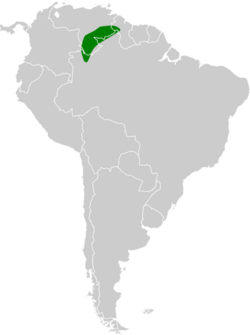Biology:Tepui swift
| Tepui swift | |
|---|---|
| Scientific classification | |
| Domain: | Eukaryota |
| Kingdom: | Animalia |
| Phylum: | Chordata |
| Class: | Aves |
| Clade: | Strisores |
| Order: | Apodiformes |
| Family: | Apodidae |
| Genus: | Streptoprocne |
| Species: | S. phelpsi
|
| Binomial name | |
| Streptoprocne phelpsi (Collins, 1972)
| |

| |
| Synonyms | |
|
Cypseloides phelpsi Collins, 1972 | |
The tepui swift (Streptoprocne phelpsi) is a species of bird in subfamily Cypseloidinae of the swift family Apodidae. It is found in Brazil , Guyana, and Venezuela.[2][3]
Taxonomy and systematics
What is now the tepui swift was first collected in the 19th century but was not recognized as a separate species until 1972. It was originally assigned to genus Cypseloides but by the 2000s was reassigned to Streptoprocne. It and the chestnut-collared swift (C. rutila) form a superspecies. Its specific epithet honors William H. Phelps Jr.[4][5]
The tepui swift is monotypic.[2]
Description
The tepui swift is one of the smaller members of genus Streptoprocne. It is 14 to 16 cm (5.5 to 6.3 in) long and weighs about 20 to 24 g (0.71 to 0.85 oz). It has a long deeply notched tail and long broad wings. Adult males' most obvious feature is the wide orange-chestnut collar that encircles the neck and includes the upper breast, chin, throat, and most of the face. The rest of its plumage is sooty black, at times with a few white feathers on the breast below the collar. Adult females are similar to males though some have a paler breast with brown mixed in. Immatures resemble adults with the addition of pale gray edges to the underparts' feathers.[4]
Distribution and habitat
The tepui swift is found in the tepui area where southeastern Venezuela, western Guyana, and far northwestern Brazil meet. One individual has been documented in far northern Venezuela; it is not known if it was a vagrant or a migrant. The species is found in humid montane and lowland forests, montane grasslands, and around cliffs. In elevation it mostly ranges between 200 and 2,200 m (660 and 7,200 ft) but has occurred as high as 2,630 m (8,600 ft).[4][6]
Behavior
Movement
The tepui swift is thought to be a year-round resident in its range but reports from elsewhere hint at the possibility that it is migratory.[4]
Feeding
Like all swifts, the tepui is an aerial insectivore, but little is known about the details of its diet. It often feeds in flocks of 10 to 20 or more that sometimes include white-collared swifts (Streptoprocne zonaris).[4]
Breeding
The tepui swift's breeding biology is not well known. It apparently mostly nests in the northern hemisphere's late spring and early summer, though a nest with a nearly full grown nestling was photographed in early September. Few nests have been found; they were on cliffs and in rocky grottos. The early September nest was a cup of rootlets and moss on a rock shelf in a cave. There is some suggestion that the species nests in colonies.[4][6]
Vocalization
The tepui swift appears to have two flight calls, "a squeak followed by a trill and short squeals, squeek, titititititititi sui, squi, squi..." and "a slow series of reedy or hissing tic notes".[4]
Status
The IUCN has assessed the tepui swift as being of Least Concern, though its population size is unknown and believed to be decreasing. No immeditate threats have been identified.[1] It is considered uncommon to fairly common, and "[a]t least in the short term, human activity probably has little effect on Tepui Swift, although it may be vulnerable in the long term to deforestation".[4]
References
- ↑ Jump up to: 1.0 1.1 BirdLife International (2016). "Tepui Swift Streptoprocne phelpsi". IUCN Red List of Threatened Species 2016: e.T22686434A93111491. doi:10.2305/IUCN.UK.2016-3.RLTS.T22686434A93111491.en. https://www.iucnredlist.org/species/22686434/93111491. Retrieved 2 October 2022.
- ↑ Jump up to: 2.0 2.1 "Owlet-nightjars, treeswifts, swifts". August 2022. https://www.worldbirdnames.org/new/bow/swifts/.
- ↑ HBW and BirdLife International (2021) Handbook of the Birds of the World and BirdLife International digital checklist of the birds of the world. Version 6. Available at: http://datazone.birdlife.org/userfiles/file/Species/Taxonomy/HBW-BirdLife_Checklist_v6_Dec21.zip retrieved August 7, 2022
- ↑ Jump up to: 4.0 4.1 4.2 4.3 4.4 4.5 4.6 4.7 Schulenberg, T. S. and G. M. Kirwan (2020). Tepui Swift (Streptoprocne phelpsi), version 1.0. In Birds of the World (T. S. Schulenberg, Editor). Cornell Lab of Ornithology, Ithaca, NY, USA. https://doi.org/10.2173/bow.tepswi1.01 retrieved October 2, 2022
- ↑ Remsen, J. V., Jr., J. I. Areta, E. Bonaccorso, S. Claramunt, A. Jaramillo, D. F. Lane, J. F. Pacheco, M. B. Robbins, F. G. Stiles, and K. J. Zimmer. Version 24 July 2022. A classification of the bird species of South America. American Ornithological Society. https://www.museum.lsu.edu/~Remsen/SACCBaseline.htm retrieved July 24, 2022
- ↑ Jump up to: 6.0 6.1 Biancalana, Renata N.; Zampaulo, Robson A.; Costa, Júlio C. R. (2021). "First record of the Tepui Swift (Streptoprocne phelpsi) breeding on Mount Roraima, Venezuela". Wilson Journal of Ornithology 133 (4): 682-685.
Wikidata ☰ Q1152180 entry
 |


